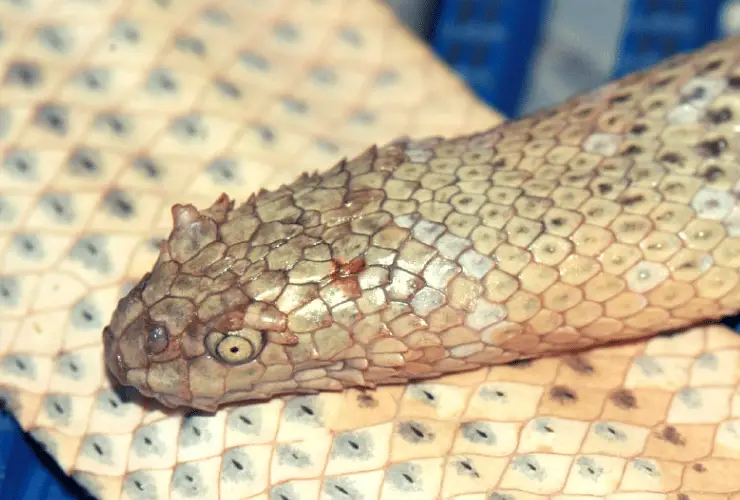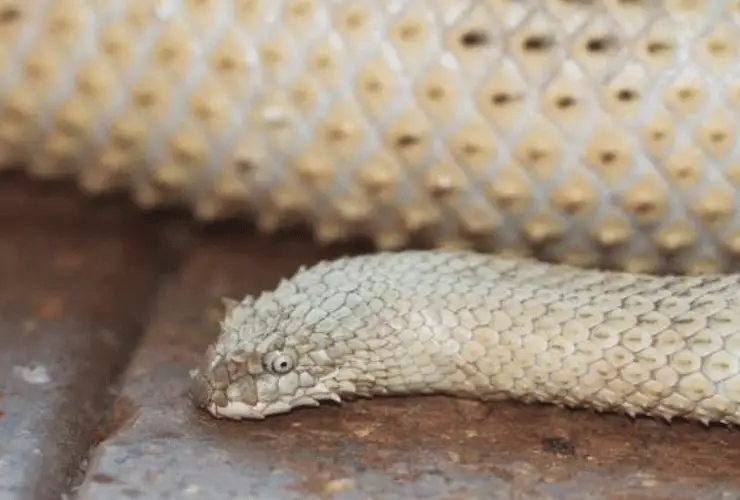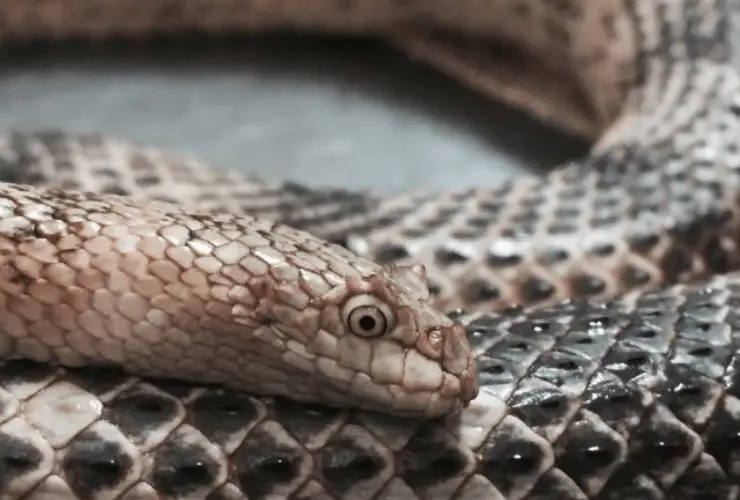Meet horned sea snakes – one of the most exotic sea species on earth. Their peculiarity is that these snakes display horny outer skin scales, located on the head and neck, which can help these snakes to live in the polar waters. The most striking thing about this harmless animal is its “horned” appearance!
Horns are just another distinguishing feature, as this sea snake also shows an extended skull with horns right above their eyebrows. The specimens pictured above were collected from a deep-sea area. Horns are especially advantageous for this reptile to be able to dive in deeper water, and also make them less visible to predators.
Do you want to know about this extraordinary snake? Then Read on, and this is how you can find out more about this fascinating species. We have tried to cover as much as we can, so you don’t have to waste your time surfing and reading long lists of references. Just jump to the article you are interested in and enjoy!
Hydrophis Peronii: Facts and Features
Kingdom: Animalia
Phylum: Chordata
Class: Reptilia
Order: Squamata
Suborder: Serpentes
Family: Elapidae
Subfamily: Hydrophiinae
Genus: Hydrophis
Species: H. peronii
Binomial name: Hydrophis Peronii (A.M.C. Duméril, 1853)
Synonyms
- Acalyptus Peronii: A.M.C. Duméril, 1853
- Acalyptus superciliosus vel Peroni: A.M.C. Duméril, Bibron, & A.H.A. Duméril, 1854
- Acalyptus superciliosus: Fischer, 1856
- Acalyptophis peronii: Boulenger, 1896
- Pseudo Disteira horrida: Kinghorn, 1926
- Hydrophis peronii: Sanders et al., 2012
Conservation Status: Least Concern (IUCN 3.1)
Length: 4 feet (up to 1.23 m)
Discussion About the Habits and Lifestyle Of Hydrophis Peronii
Let’s deep dive into what exactly Hydrophis Peronii is. What this sea snake species eats and its habits in the water.
● Classification
Before discussing the classification of this marine beast. Let’s see what is the etymology of “Hydrophis Peronii”. The specific name, peronii, honors French explorer and naturalist François Péron. However, “Hydrophis” comes from its genus.
A species of venomous sea snake belonging to the subfamily Hydrophiinae of the family Elapidae is called Hydrophis peronii. The only sea snake with spines on its head is this one. It’s occasionally given its genus, Acalyptophis.
This species of snake belongs to the kingdom of Animalia with
Chordata phylum in the class of Reptilia under the order of Squamata. Its family is Elapidae and its subfamily is Hydrophiinae.
● Habitats of Hydrophis Peronii
H. peronii prefers sand-bottomed oceans and coral reefs as its habitats. The Indo-Pacific Ocean is the most typical region of this species. There are at least 20 reported sightings worldwide.
Hydrophis Peronii often inhabits sandy bottoms and coastal areas. It is usually found near a high tide line. The depth of it can reach 200 to 1,000 feet. For now, they are also spotted in the Mediterranean and Baltic Sea.
There are fewer reports of hydrophis peronii swimming or rising to the surface. So, it is difficult to study them. But they usually find themselves on the ground and hunt in that region.
● Body Shape
The neck diameter of the spiny-headed sea snake is only one-third to two-fifths the diameter of the thickest region of the body, making it a medium-sized snake. The tail is flattened laterally, and the skull is tiny.
The open margins of the supraoculars are sharp, and they are elevated. H. peronii is relatively small in size for the genus it belongs to. This species can grow up to 1.23 m in snout-vent length (SVL) (4.0 ft). Like most venomous snakes, the venomous part of this sea snake, the venom gland, is located in the mouth.
It has dark crossbands on the dorsal side that are tapered to a point on the sides of the belly and are narrower than the spaces between them. Dorsally, it is grayish, pale olive, or tan. It is uniformly white on the ventral side or has a sequence of dark crossbars that alternate with dots.
As you are thinking now, Yes! The area directly above the eyes of Horned Sea snakes is covered in two horn-like structures. It’s speculated that this sea snake uses its “horned” appearance to stay away from predators.
● Diet and Nutrition
All sea snakes feed on eels and small fishes. Hydrophis Peronii also feeds on the same. However, it prefers gobies above other tiny fish as prey. It searches reef crevices and burrows in the late afternoon and at night for sleeping gobies (nocturnal hunters).
They use their venom to cripple the prey. The prey is swallowed whole. Fish eggs are also included in their favorite foods list. As part of the digestion process, the intestine may get stuck for a while in the esophagus.
The stomach contents of the stingless sea snake consist of a soft cuttlebone, segments of the muscles, and one or two gelatinous organelles. The complete dietary lifestyle of these curious animals is still unknown.
● Hydrophis Peronii and Human
Peron’s sea snakes are ductile. It also represses defense from humans. The adults do not usually kill their prey and don’t usually bite when handled. However, people have been reported to get stung accidentally.
On the other hand, the “snakes” can be dangerous to people who cause a wrong sense of thinking. If a small child jumps on a snake, the adult will feel offended and might sting the child.

The subadult will scratch the child with his tail, but this type of attack is often unnoticed and therefore unnoticed by parents and caregivers. Since there have been such reported cases, adults will likely treat humans the same way.
So, children are warned not to leap on any hidden or crawling snake, especially if it is not in a friendly or food mode. This is one good way to protect oneself from getting bitten by these harmful creatures.
They can attack when they feel their life is in danger. There are rare instances of them biting people or getting caught in fishing nets. A person bitten by this snake needs immediate medical care.
● Reproduction
Let’s start with the general observation that there are two main types of sea snakes. There are oviparous sea snakes that lay clutches of eggs on the sand. And then there are the viviparous ones that produce live young. Hydrophis Peronii belongs to the viviparous species of sea snakes.
10 live young pups can be produced per female. The dark bands that make up the snake’s color are more noticeable when it is a juvenile; as the young snakes’ age, the bands start to diminish and occasionally vanish. Its yearly cycle of reproduction lasts from March to June.
● Population
For the horned sea snake, there is no information on population size, population composition, or generation length. In this species, there hasn’t been any evidence of crossbreeding.
According to the answer given by kidadl.com’s research, “the continent of Australia is particularly included in the large distribution range of the Peron’s sea snake. The quantity of these snakes in existence worldwide is not, however, listed.” (Source)
What about their conservation status? According to IUCN, hydrophis peronii conservation status is “Least Concern“. These sea snakes don’t seem to be in danger, but the fishing net manages to catch them. (Source)
Where Does Hydrophis Peronii Live?
Authors of Wikipedia organization have stated the following locations where Hydrophis Peronii live:
“Hydrophis peronii is found in the Gulf of Siam, Thailand, Vietnam, the South China Sea, the coast of Guangdong and Strait of Taiwan, the Philippines, Indonesia, New Guinea, New Caledonia, the Coral Sea Islands, Papua New Guinea, and Australia, (Northern Territory, Queensland, Western Australia, & possibly New South Wales).” (Source)
It lives in all coral reefs and possibly off the fringing reefs. The population of Hydrophis Peronii could be anywhere in the world, but these snakes are usually most found in the waters of the Northern Territory, Queensland, and Western Australia.
Is The Hydrophis Peronii Venomous? How Venomous Is It?
Yes, Hydrophis Peronii is venomous. This sea snake uses its venom as a defense mechanism, and in other situations for the defense. However, the venom is not regarded as a particularly deadly poison as other sea snakes’ venom.
This is because it does not deliver a large amount of damage to the heart and circulatory system. That is why the mortality rate of sea snakes isn’t so high. By the way, if it’s not treated within the first few hours, it can be fatal.
This sea snake also uses its venom for defense, which can result in local tissue damage. This doesn’t mean that Hydrophis Peronii is a weak venomous snake. It still can deliver a lot of harm to people. Hydrophis Peronii can deliver a paralyzing venom that can immobilize you.
What Are the Causes of The Hydrophis Peronii Bite?
When a person comes into touch with a venomous sea snake, usually unwittingly or accidentally, they risk getting bitten by a horned sea snake. There are many other causes of the Hydrophis Peronii bite.
- Although the sea snake is typically calm, it has been known to bite when provoked. When the snake is aroused, anyone who comes into contact with it may get bitten in self-defense.
- The venom of horned sea snakes contains potent neurotoxins that can result in death or paralysis and disrupt neuromuscular communication. Despite the rarity of envenomation, the fast-acting venom can quickly tear down muscles and induce neurological symptoms within a few hours. (Source)
Sea snake venom is frequently many times more potent than land snake venom, according to scholarly research. However, while almost all of the venomous sea snakes in existence are viper species, the venom of this one, and possibly the others, cannot be compared directly to that of vipers because the venom of this species contains many different components.
What Are the Symptoms of Hydrophis Peronii Bite?
Initial symptoms noticed between five minutes and two hours ago could include:
- Bite or fang marks on the arm or leg; in some cases, the teeth may break off and remain in the wound
- There may be no pain to negligible pain and swelling at the bite site
- Nausea, vomiting, and diarrhea
- A sensation of thick tongue
- Dryness of throat
- Headaches
- Feeling sweaty and/or thirsty
- Anxiety, drowsiness, and confusion
- Pain, fatigue, and weak muscles
- Body aches and muscle aches; stiffness of the body and neck
Symptoms that may be seen after several hours (four to eight hours or more) include:
- Abdominal pain
- Poor reflexes
- Locally enlarged lymph nodes
- Drooling from the mouth; uncontrollable saliva flow from the mouth
- Trismus or difficulty opening mouth (same as lockjaw)
- Droopy eyelids and blurred vision
- Breathing difficulties; labored breathing
- Blabbering, speaking difficulties
- Feeling faint or dizzy
- Dark-colored urine
- Blue-colored skin due to poisoning
- Weakness and malaise
- Unconsciousness
It must be noted that in cases of severe bites, the onset and progression of symptoms may occur quickly—in as little as one to two hours. In such circumstances, the progression from the initial symptoms to cardiac arrest, respiratory failure, and/or paralysis may occur suddenly.
Note: The patient may exhibit extra perplexing symptoms if alternative or native remedies have been used to treat them. So, it’s crucial to swiftly seek medical advice from a certified professional whenever possible.
Is There Any Antivenom for The Treatment of Hydrophis Peronii Bite?
Yes, there are a lot of antivenoms for the treatment of hydrophis peronii. “Antivenin polyvalent sea snake” is one of them. But keep in mind that all venomous species are not treated with antivenom. They can cause severe reactions. Usually, the snake is treated as soon as possible after being bitten.

Typically, most patients receive the maximum amount of first aid they can tolerate. Within an hour of the bite, the hemorrhaging from the snake bite is likely to have started, and within two to four hours, serious systemic problems may begin. The fact is that it’s better to try to avoid getting bitten than to try to cure it by using the medicine.
How To Prevent Hydrophis Peronii Bite?
Here are a few useful guidelines to prevent Hydrophis Peronii bite:
Do’s:
- Do report the snake, in case it is still in the ground.
- Do report the snake, in the case that it is not more than 10 feet or so from the surface, as it often stays in the shallow soil.
- Do cover your mouth with a mitt or a handkerchief, to prevent the snake from sticking its fangs in your mouth.
- Do ensure that no openings of the skin are made, to allow the venom to enter and take effect.
- If you find a dead snake, do not touch it with your hands.
- Do cover it, and keep it at least 15 feet from the house.
- Do not go for walk at night as you may be bitten.
Don’t’s:
- Do not approach or touch the snake.
- Do not use a shovel, stick, machete, prybar, or any other object to disturb the animal.
- Do not handle it.
- Do not throw a stick, stone, or any other object at it.
- Do not try to hit the snake with a bucket, water bucket, hoe, rifle, or any other object.
- Do not wait until it moves or if it makes a sudden movement.
List Of Fascinating Facts About Hydrophis Peronii
Do you know the following facts?
- Hydrophis Peronii must rise to the surface of the water like a whale to breathe regularly because they lack gills. They have unique underwater nostril valves that close. They can stay up to 8 hours in the water.
- Since a snake normally injects the same amount of venom into a person, the antivenom dosage is the same for children, adults, and even pregnant women.
- The venom of Hydrophis Peronii is less toxic than that of the most dangerous snakes but its looks are more dangerous than any other snake due to the coloration of the skin and horns.
- Hydrophis Peronii has the highest geographic distribution of any species of snake in the world.
- This is a dangerous sea snake, and it is not appropriate for keeping it as an exotic pet.
FAQ
Are there giant sea snakes?
Yes, there are giant sea snakes ranging from 6 feet to 10 feet in length. These sea snakes are also found in South America, so it is not rare. They are considered to be very rare and not easy to get. Hydrophis spiralis can reach up to ten feet – these sea snakes are considered to be the largest and giant sea snakes.
What is the deadliest sea snake?
Enhydrina schistosa or beaked sea snake is known as the deadliest sea snake in the world. It is responsible for the majority of sea snake bites globally. The horned sea snake is not as deadly a snake as enhydrina schistosa.
What are the common names of Hydrophis Peronii?
The common names of Hydrophis Peronii include Spiny-headed sea snake, Peron’s sea snake, eyelash sea snake, and Horned sea snake. You can also call it with names of Acalyptophis peronii, Pseudo Disteira horrida, Acalyptus superciliosus, and Acalyptus superciliosus vel Peroni.
How toxic is the Hydrophis Peronii venom?
The venom of Hydrophis Peronii is highly potent and neurotoxic and can easily kill a human if not treated urgently. However, the venom is considered to be milder than that of other sea snakes.
Can a Hydrophis Peronii bite kill you?
Yes, but it is considered extremely dangerous if untreated. The toxic venom can cause severe pain, inflammation, blood clotting, and internal hemorrhaging. More than 7% of all fatal snake bites occur in sea snakes.
Conclusion
Hydrophis peronii is a mediocre-level venomous sea snake that can cause severe complications. The outcome is not good, and the victims have to be hospitalized immediately. Do not try to capture a Hydrophis Peronii if you come across one. Learn the history of this snake and keep them away from you as they are dangerous.
So, what do you think about this snake? Do you have any questions about it? Leave a comment below, let us know your opinions, and let us know more interesting facts about it.
Image Source:

